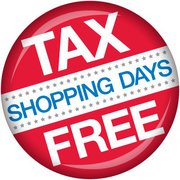Tax Free Week for CT Shoppers, National Retailers Upbeat
/Connecticut’s annual holiday from the sales tax begins on August 19 and runs through August 25. The traditional tax-free week - now in its 12th year - was threatened with elimination during last year’s budget debate at the State Legislature, but survived intact. Tax free purchases are expected to cost the state - and save consumers - as much as $7.5 million statewide, according to the state Department of Revenue Services. The state sales tax is 6.35 percent. On average, it is estimated that families will spend nearly $700 on back to school purchases this year.
During this third week of August, individual items of clothing and footwear that cost less than $300 are completely exempt from state sales tax. Sports equipment, specialty clothing, jewelry and accessories are not included. In addition, the tax free holiday week includes items valued at more but discounted to under $300 with sales, coupons and similar merchant promotions . Store sales, catalog and on-line purchases, purchases on layaway and rentals are exempt.
. Store sales, catalog and on-line purchases, purchases on layaway and rentals are exempt.
For more information, individuals may call 1-800-382-9463 (for in-state calls outside the Greater Hartford Area) or 860-297-5962 (from anywhere).
The sales tax free week comes as retailers look for a boost from back-to-school sales and prepare for the holiday shopping season. The National Retail Federation’s Global Port Tracker report is showing a strong increase in imports for August, September and October – the three key months of the year when retailers import the bulk of the merchandise they will sell during the holiday season.
August imports are expected to be 6.3 percent higher than last year, September should be up 7.3 percent, and October is forecast at 13.2 percent above last year. Averaged out, that’s an 8.9 percent increase over last year, NRF reports. Imports fall off in November and December because most holiday merchandise is already on the shelves, but each of those months is expected to be 2.4 percent above last year. Although those numbers don’t translate directly into sales – they report the number of cargo containers coming into the country, not the value of the merchandise inside – they are seen nonetheless as a source of optimism, according to industry observers.





























